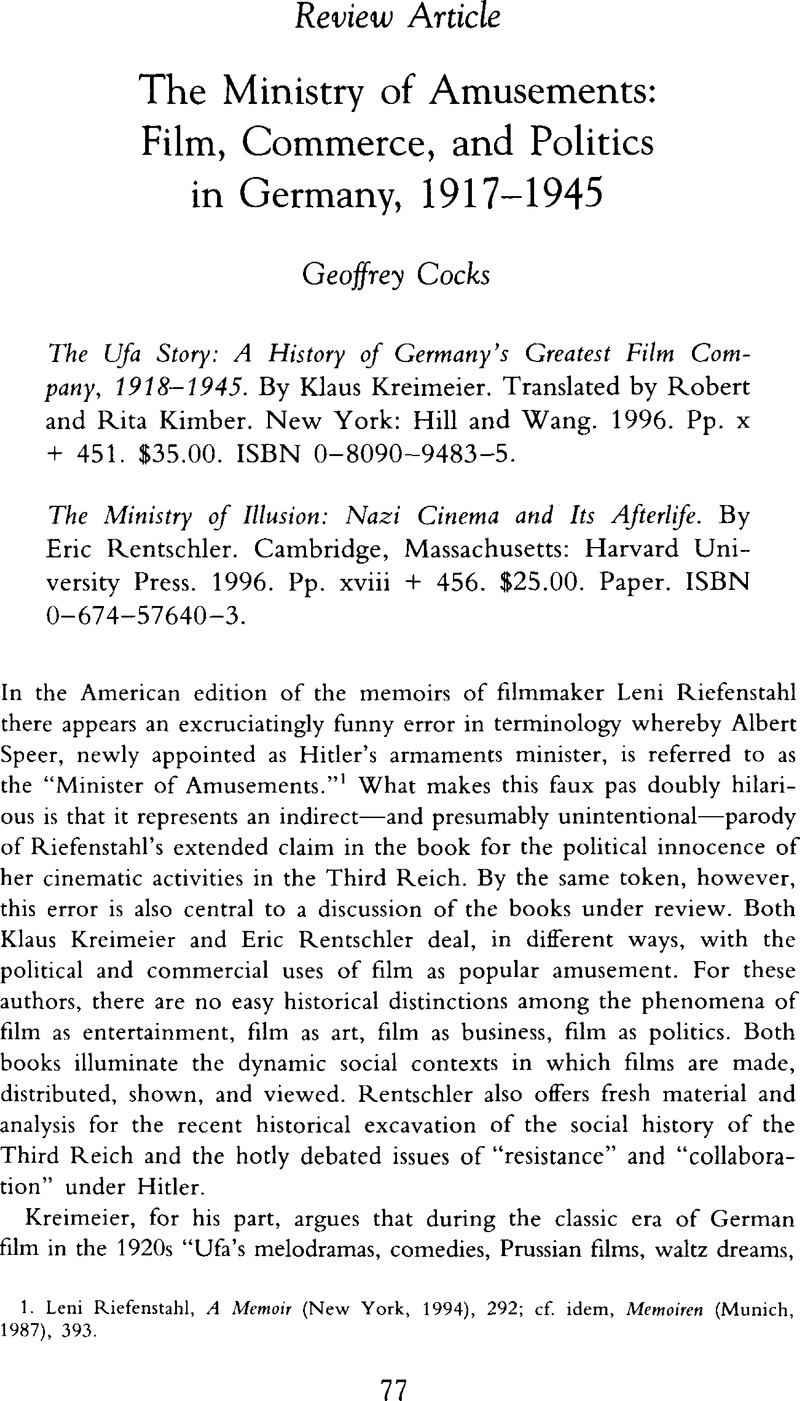Published online by Cambridge University Press: 16 December 2008

1. Riefenstahl, Leni, A Memoir (New York, 1994), 292Google Scholar; cf. idem, Memoiren (Munich, 1987), 393.Google Scholar
2. Kreimeier, Ufa Story, 176.
3. Rentschler, Ministry of Illusion, 15, 91, 201.
4. Kreimeier, Ufa Story, 126.
5. Janowitz, Hans, “Caligari—The Story of a Famous Story (Excerpts),” in The Cabinet of Dr. Caligari: Texts, Contexts, Histories, ed. Budd, Mike (New Brunswick, NJ, 1990), 221–39Google Scholar; Donahue, Neil H., “Unjustly Framed: Politics and Art in Das Cabinet des Dr. Caligari,” German Politics and Society 32 (1994): 76–88Google Scholar; Kracauer, Siegfried, From Caligari to Hitler: A Psychological History of the German Film (Princeton, 1947), 61–76, 99–102.Google Scholar
6. Kreimeier, Ufa Story, 149.
7. Nolan, Mary, Imagining America, Modernizing Germany: Fordism and Economic Reform in the Weimar Republic (New York, 1994)Google Scholar; Peukert, Detlev J.K., Inside Nazi Germany: Conformity, Opposition, and Racism in Everyday Life, trans. Deveson, Richard (New Haven, 1987), 77–78, 180, 247.Google Scholar
8. Kreimeier, Ufa Story, 239.
9. Ibid., 233.
10. Rentschler, Ministry of Illusion, 7, 216.
11. Hull, David Stewart, Film in the Third Reich: Art and Propaganda in Nazi Germany (Berkeley, 1969).Google Scholar
12. Rentschler, Ministry of Illusion, 16–24.
13. Ibid., 39, 43.
14. Sontag, Susan, “Fascinating Fascism” (1975), in Sontag, Under the Sign of Saturn (New York, 1981), 71–105.Google Scholar
15. Rentschler, Ministry of Illusion, 65; Theweleit, Klaus, Male Fantasies, trans. Conway, Stephen et al. , 2 vols (Minneapolis, 1987, 1989)Google Scholar; Bateson, Gregory, “An Analysis of the Nazi Film Hitlerjunge Quex,” in The Study of Culture at a Distance, ed. Mead, Margaret and Métraux, Rhoda (Chicago, 1953), 302–14.Google Scholar
16. Rentschler, Ministry of Illusion, 78; see also 92: Trenker's film suggests some of the same dark American qualities about the Heimat, an ambiguity captured in Freud's analysis of the word “uncanny” (unheimlich); Cocks, Geoffrey, “Bringing the Holocaust Home: The Freudian Dynamics of Kubrick's The Shining,” Psychoanalytic Review 78 (1991): 103–25.Google ScholarPubMed
17. Rentschler, Ministry of Illusion, 94.
18. Ibid., 122.
19. Geyer, Michael, “Resistance as Ongoing Project: Visions of Order, Obligations to Strangers, and Struggles for Civil Society, 1933–1990,” in Resistance Against the Third Reich, 1933–1990, ed. Geyer, Michael and Boyer, John W. (Chicago, 1992), 325–50.Google Scholar
20. Rentschler, Ministry of Illusion, 135.
21. Ibid., 154.
22. Goldhagen, Daniel Jonah, Hitler's Willing Executioners: Ordinary German and the Holocaust (New York, 1996).Google Scholar
23. Daniel Jonah Goldhagen, “Motives, Causes, and Alibis: A Reply to My Critics,” New Republic, 23 December 1996, 37–45. Goldhagen also argues that the police battalions who carried out many of the mass murders of Jews were representative of Germans as a whole since their members came from all social classes. But even if police battalions were representative of German society and dominated by anti-Semitism, Goldhagen fails to consider whether choice of employment in the police selects out those from any social class who would more likely be anti-Semitic and/or more willing to “follow orders.” See also Littel, Franklin H., ed., Hyping the Holocaust: Scholars Answer Goldhagen (East Rockaway, NY, 1997).Google Scholar
24. Berlin, Reichspropagandaamt, Vertrauliche Mitteilungen!, 27 04 1940, in Theater und Film im Dritten Reich: Eine Dokumentation, ed. Wulf, Josef (Hamburg, 1996), 448.Google Scholar
25. Monaco, Paul, Cinema and Society: France and Germany during the Twenties (New York, 1976).Google Scholar
26. Cocks, Geoffrey, Psychotheraphy in the Third Reich: The Göring Institute, 2nd, rev. ed. (New Brunswick, NJ, 1997), chap. 6.Google Scholar
27. Kreimeier, Ufa Story, 287, 311, 369, 372; Rentschler, Ministry of Illusion, 136, 218, 235.
28. Cocks, Geoffrey, “The Old as New: The Nuremberg Doctors' Trial and Medicine in Modern Germany,” in Medicine and Modernity: Public Health and Medical Care in Nineteenth- and Twentieth-Century Germany, ed. Berg, Manfred and Cocks, Geoffrey (Cambridge, 1997), 173–91.CrossRefGoogle Scholar
29. Kreimeier, Ufa Story, 175–76.